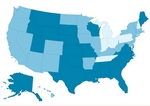government
Health reform rule makes preventive care free for many
■ Tens of millions of health plan patients still may be subject to co-pays, but that figure will decrease over time.
- WITH THIS STORY:
- » Free care list
- » External links
Washington -- Health plans that are created or significantly changed after Sept. 22 must cover a variety of evidence-based preventive services without requiring co-pays or other cost sharing, says an interim final rule released July 14 by the Health and Human Services, Treasury, and Labor Depts.
The rule names a list of vaccines, preventive screenings and services for adults and children endorsed by federal scientific panels, including tests for cancer, heart ailments, obesity and other conditions. It also includes a list of preventive services for women that will be developed by a new federal panel next year.
The rule's impact will grow over time as health plans lose exemptions from the health reform law. For example, plans could change their benefits or cost-sharing practices.
In 2011, some 31 million people are expected to be enrolled in health plans that will be affected by the rule, increasing to about 78 million in 2013, HHS estimated. An estimated 98 million people still will be enrolled in exempted health plans in 2013. HHS said the rule is more likely to benefit people with individual and small-group coverage.
The preventive services rule is one of many authorized by the health reform law. Other regulations formalize the law's ban on canceling coverage for people who get sick, extend health insurance eligibility for dependents to age 26 and tighten restrictions on annual coverage limits.
"The [Obama] administration is laying the foundation to help transform the health care system from a system that focuses on treating the sick to a system that focuses on keeping every American healthy," HHS Secretary Kathleen Sebelius said in a July 14 statement.
"This rule is a major victory for children and their families," Judith S. Palfrey, MD, president of the American Academy of Pediatrics, said in a July 15 statement. The rule follows the Bright Futures children's preventive care guidelines created by the AAP and the Health Resources and Services Administration. Covered services include all components of pediatric well-child visits -- physical exams, immunizations, hearing and vision screening, and developmental and behavioral screening, she said.
The rule correctly focuses on preventive services with scientific justifications, said Susan Pisano, spokeswoman for America's Health Insurance Plans. "If you look historically at a lot of state-mandated benefits, states have not really required analysis of the impact on quality."
Pisano said HHS carefully considered the rule. "We think they worked hard to strike a good balance between expanding access to preventive services and mitigating the potential impact on the cost of coverage."
AHIP doesn't know how many health plans require co-pays for these preventive services, Pisano said. Many plans cover the services, though the association does not have an exact figure.
Eliminating co-pays for preventive services is significant, said Lori Heim, MD, president of the American Academy of Family Physicians. A $20 co-pay is enough to discourage some families from taking in their child for a checkup. "The co-pays actually do create a barrier," she said.
American Medical Association President Cecil B. Wilson, MD, said the Association strongly supports investments in prevention and wellness. "The interim final rule released by HHS is an important step toward reducing the prevalence of chronic disease, reducing health care costs, and improving the quality of Americans' health and lives."
Higher profile for panel
The rule puts decisions of the U.S. Preventive Services Task Force in a brighter spotlight, said Ned Calonge, MD, MPH, panel chair and chief medical officer for the Colorado Dept. of Public Health and Environment. The rule requires affected health plans to pay for the list of screenings, tests and other services graded A or B by the task force. The list has 45 items so far.
The change in federal law means each proposed addition to task force recommendations may be subject to more public scrutiny, Dr. Calonge said. The task force must work to keep the process of developing new guidelines free from influence from lobbyists and others. "It will be a challenge," he said.
Most task force recommendations are noncontroversial. But in November 2009, the panel suggested that women under 50 should not get routine mammograms and that women should not be taught breast-self examination, among other changes. The new advice met with strong criticism.
Task force priorities are based partly on the burden of diseases. A common illness with significant health effects will be a higher priority than a disease affecting fewer people, Dr. Calonge said. "We want to make sure we review topics where recommendations might make a difference."
Dr. Calonge noted that the rule does not remove any cost barriers for the treatment of diseases or conditions -- just for the preventive screenings and tests that can uncover them. With the exception of colonoscopies, there are no screenings that by themselves improve health, he said. However, task force guidelines are based on scientific evidence and are sometimes the first step toward health plans covering certain medical services to treat the underlying conditions, Dr. Calonge said.
HHS, Treasury and Labor are accepting comments on the preventive services rule until Sept. 17.












